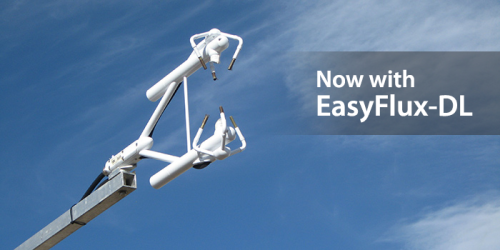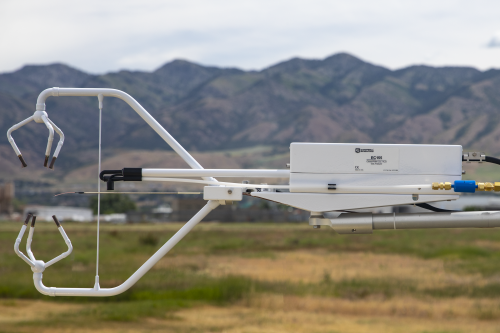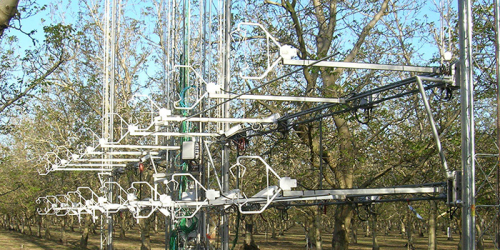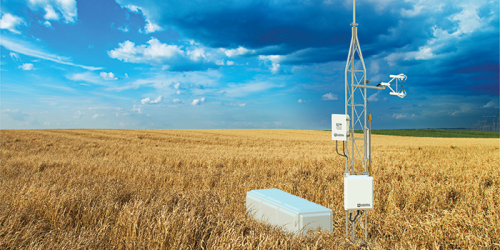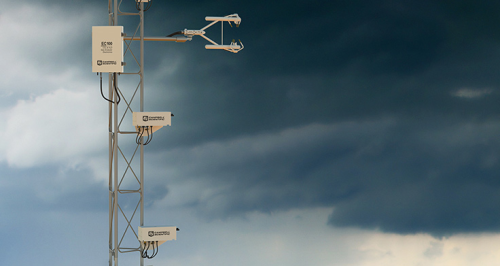Was wir tun
Campbell Scientific offers a variety of micrometeorological systems for measuring turbulence and fluxes of greenhouse gases (CO2, H2O, CH4, N2O, and CO2 isotopes) and energy (sensible heat, latent heat, and momentum). We offer the lowest total system power available for open-path (5 W) and closed-path (12 W) eddy covariance over the entire instrument operating temperature. This, combined with our ruggedized designs and low-maintenance operation, makes our systems the ideal choice for sites in remote or challenging conditions. We are unique among flux system providers in that we manufacture all key system components: 3D sonic anemometers, gas analyzers, sampling systems, and data loggers. This enables us to make our systems much more highly integrated, taking into account important system-level considerations such as sensor colocation and mounting, high-speed measurement synchronization, sensor aerodynamics, and whole-system frequency response. Finally, our patented colocated design of the IRGASON is the only open-path CO2/H2O gas analyzer that allows for flux calculations using instantaneous point-by-point conversion to CO2 mixing ratio, which eliminates the need to correct for density effects on the measurement.
Mehr erfahrenWeitere Details über unsere Gas Flux and Turbulence Systeme
Systemkomponenten
Datenlogger
Der Datenlogger der Wahl für Eddy-Kovarianzsysteme ist im Moment der CR3000. Er ist schnell, hat genügend Eingangskanäle und man kann vorgefertigte Programme von Campbell Scientific erwerben.
Sensoren und Gasanalysatoren
An unseren Datenloggern können verschiedene Gasanalysatoren angeschlossen werden. Campbell bietet eigene Gasanalysatoren an, den EC150 und EC155 für open- und closed-path Messungen. Vorteil bei Verwendung zusammen mit dem CSAT3 von Campbell ist das ineinandergreifende Design und die einfachere Datenverarbeitung. Aber auch Licor Gasanalysatoren werden häufig an unseren Stationen verwendet. Zusätzlich können Hygrometer, haarfeine Thermoelemente, ein Strahlungsbilanzsensor oder Sensoren zur Erfassung von Bodenparametern angeschlossen werden.
Datenabfrage
Die Daten der Eddy-Kovarianzmessungen werden üblicherweise auf einer Speicherkarte (bis 16Gb) abgelegt. Datenfernabfrage ist aufgrund der großen Datenmengen nicht praktikabel, aber zur Überprüfung des Status einer Staion bieten wir GPS, GPRS usw. an.
Zusätzliche Sensoren für Energiebilanz:
| HC2S3 Sensor für Temperatur und relative Luftfeuchte |
 |
| NR-LITE2 Strahlungsbilanzsensor |
 |
| NR01 4-Komponenten-Strahlungsbilanzsensor |
 |
| CNR4 4-Komponenten-Strahlungsbilanzsensor |
 |
| TCAV Sensor für durchschnittliche Erdbodentemperatur |
 |
| CS616 Bodenfeuchtesensor |
 |
| CS650 30 cm –Bodenfeuchtesensor, SDI12 |
 |
| CS655 12 cm –Bodenfeuchtesensor, SDI12 |
|
| HFP01 Bodenwärmeflussplatte |
 |
| HFP01SC Selbstkalibrierende Bodenwärmeflussplatte |
 |
Dokumente
Broschüren Produkte
Anwendungsbeispiele
Understanding the spatial variability of the Earth’s atmospheric boundary layer—including the surface layer near the......lesen Sie mehr
Overview In the fight against climate change, innovative solutions are emerging to address the global challenge......lesen Sie mehr
The Warra long-term ecological research (LTER) site located in Southwestern Tasmania was founded in 1995......lesen Sie mehr
Forest habitats contribute more than any other terrestrial biome to carbon cycles and processes. It......lesen Sie mehr
Understanding the exchanges of energy, water, and carbon dioxide between the atmosphere, land, and plants......lesen Sie mehr
An experimental facility (OzFace) has been established in Townsville, Australia to examine the impacts of......lesen Sie mehr
Three Bowen ratio stations monitor CO2 fluxes in the grasslands of Central Asia. The stations,......lesen Sie mehr
With instrumentation and help from Campbell Scientific, personnel from the Department of Atmospheric Sciences at......lesen Sie mehr
FAQs für
Number of FAQs related to Gas Flux and Turbulence: 1
-
Most Campbell Scientific systems are built from individual components. This provides maximum flexibility for our customers, but it does not lend itself to pricing a "typical" system. Contact Campbell Scientific for assistance in pricing a system to meet the unique needs of the application.
Artikel und Pressemitteilungen
Newsletter Artikel
Pressemitteilungen
Privacy Policy Update
We've updated our privacy policy. Learn More
Cookie Consent
Update your cookie preferences. Update Cookie Preferences



